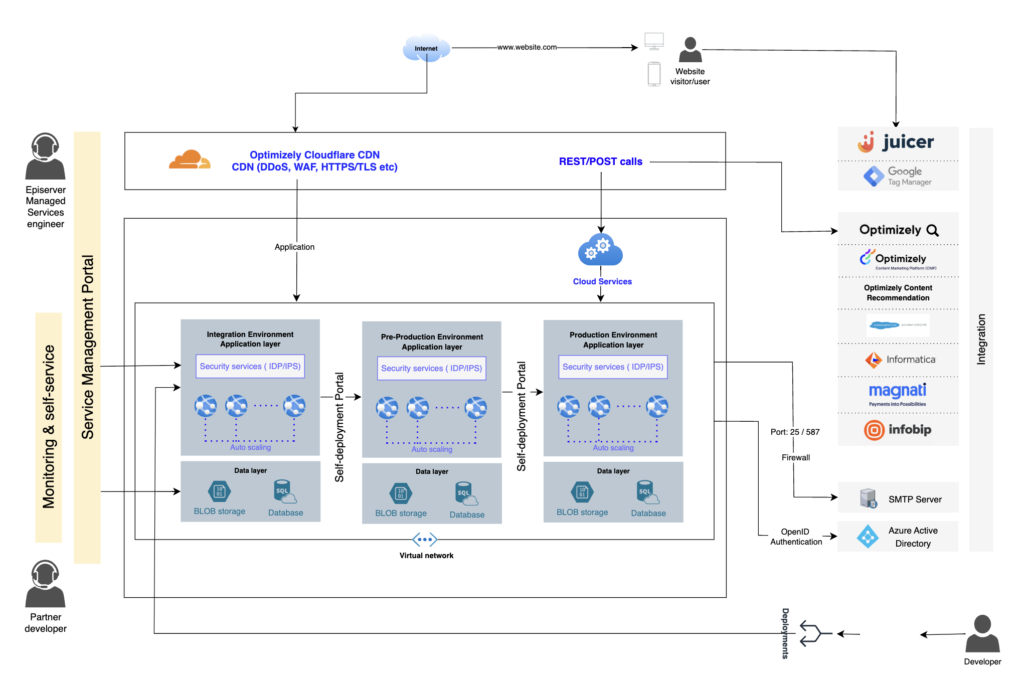Introduction
Having recently worked on an Optimizely project, I gained valuable insights into the capabilities and best practices of the Optimizely DXP environment. This experience reinforced my understanding of its scalability, security, and performance optimizations. I worked on a migration project from Sitecore to Optimizely, which involved migrating five complex websites originally built on Sitecore and WordPress to Optimizely. This migration required careful planning, content restructuring, and performance optimization to ensure a seamless transition. To successfully deliver this project, I collaborated with an incredible team of 25+ professionals, each contributing expertise across development, architecture, quality assurance, and deployment.
Optimizely Digital Experience Platform (DXP) is a powerful cloud-based solution designed to help businesses deliver exceptional digital experiences. It provides a scalable, secure, and high-performance environment for managing and optimizing content. This blog will explore the key components, benefits, and best practices for working with Optimizely DXP.
What is Optimizely DXP?
Optimizely DXP is a Platform-as-a-Service (PaaS) offering that provides a fully managed cloud infrastructure to host and deploy websites built on Optimizely CMS. It ensures high availability, security, and performance while streamlining development and deployment processes.
Optimizely DXP Architecture
Optimizely DXP provides a standard architecture with three key environments:
- Integration Environment:
- Used for development and integration testing.
- Developers deploy and test code before promoting it to higher environments.
- Connected to Optimizely PaaS Portal for deployment management.
- Pre-Production Environment:
- Serves as a staging environment to test releases before production.
- Used for final user acceptance testing (UAT) and performance validation.
- Mirrors the production environment to ensure stability.
- Production Environment:
- The live environment serving end-users.
- Fully optimized for performance, scalability, and security.
- Managed through Optimizely’s cloud hosting infrastructure.
Below is a visual representation of Optimizely DXP architecture in our previous project:

PaaS Portal
The Optimizely PaaS Portal is a critical component of DXP, allowing developers and administrators to:
- Manage environment deployments and promote code between environments.
- Monitor application performance and logs.
- Access backup and disaster recovery features.
- Manage database operations such as backups and restores.
Optimizely DAM (Digital Asset Management)
Some customers require a centralized asset repository, and Optimizely DAM plays a vital role in fulfilling this need. Recently, Optimizely integrated Welcome DAM into its Content Marketing Platform (CMP), making Optimizely CMP function as a DAM as well. This provides businesses with a seamless way to manage digital assets within the Optimizely ecosystem.
The integration between Optimizely CMS and CMP is smooth and easy, allowing content editors to efficiently organize, retrieve, and publish digital assets without needing external asset management tools. This streamlined approach enhances content workflows and ensures consistency across digital experiences.
Optimizely Search & Navigation
Optimizely Search & Navigation (formerly known as Find) is a powerful, cloud-based search solution that enhances website performance and user experience by providing fast, relevant search results. Key features include:
- Faceted Search: Allows users to refine search results with filters.
- Auto-Suggestions & Synonyms: Enhances user experience with predictive text.
- Multi-Language Support: Ensures global reach with multilingual search capabilities.
Integrating Optimizely Search & Navigation with Optimizely CMS ensures that content is indexed efficiently, making it easily searchable for users. This improves site usability, engagement, and overall digital experience.
Benefits of Optimizely DXP
- Scalability: Automatically adjusts to handle traffic spikes and increased workloads.
- Security & Compliance: Follows industry best practices, including GDPR compliance and enterprise-level security.
- Faster Time to Market: Pre-built integrations, managed infrastructure, and automation streamline deployment.
- Improved Performance: Optimized cloud hosting enhances speed and reliability.
Best Practices for Working with Optimizely DXP
1. Leverage the Multi-Environment Setup
Optimizely DXP provides multiple environments, including Integration, Preproduction, and Production. Utilize these environments effectively for testing, staging, and live deployments.
2. Follow DevOps Best Practices
- Use Optimizely’s continuous deployment model to automate releases.
- Implement CI/CD pipelines for seamless deployment.
- Use feature flags for controlled rollouts.
3. Optimize Performance with Caching
- Leverage Optimizely’s CDN for faster content delivery.
- Use output and object caching to improve load times.
- Optimize search queries and indexing for better performance.
4. Ensure Security & Compliance
- Implement role-based access control (RBAC) to restrict permissions.
- Regularly audit security logs and monitoring tools.
- Keep the platform updated with the latest security patches.
5. Monitor & Maintain the Platform
- Use Application Insights and Optimizely DXP monitoring tools to track performance.
- Set up alerts for anomalies or errors in the application.
- Regularly review deployment logs to ensure smooth operation.
Conclusion
Optimizely DXP is a powerful solution for organizations looking to enhance their digital presence. By leveraging its features and best practices, businesses can build scalable, secure, and high-performing digital experiences. Whether you are migrating to Optimizely DXP or optimizing an existing implementation, following the recommended guidelines will help you achieve better outcomes and user engagement.
Are you using Optimizely DXP in your projects? Share your experiences in the comments below!
Well explained all the components associated with DXP.